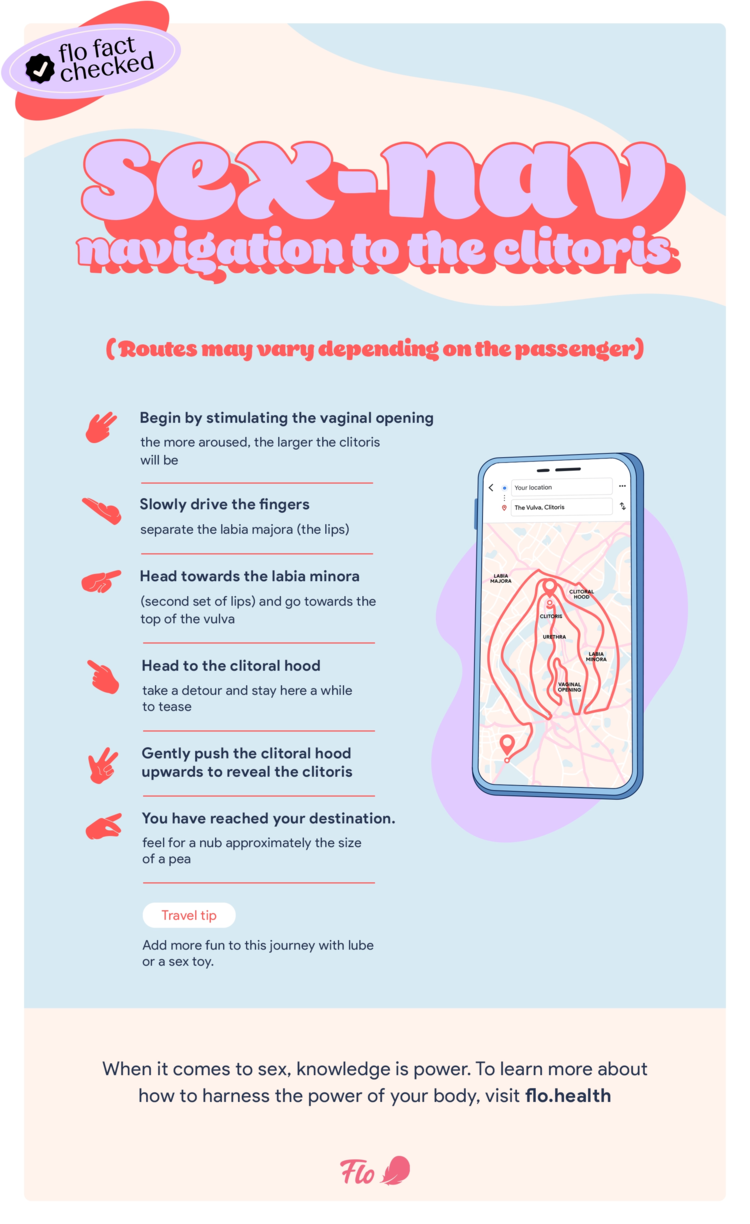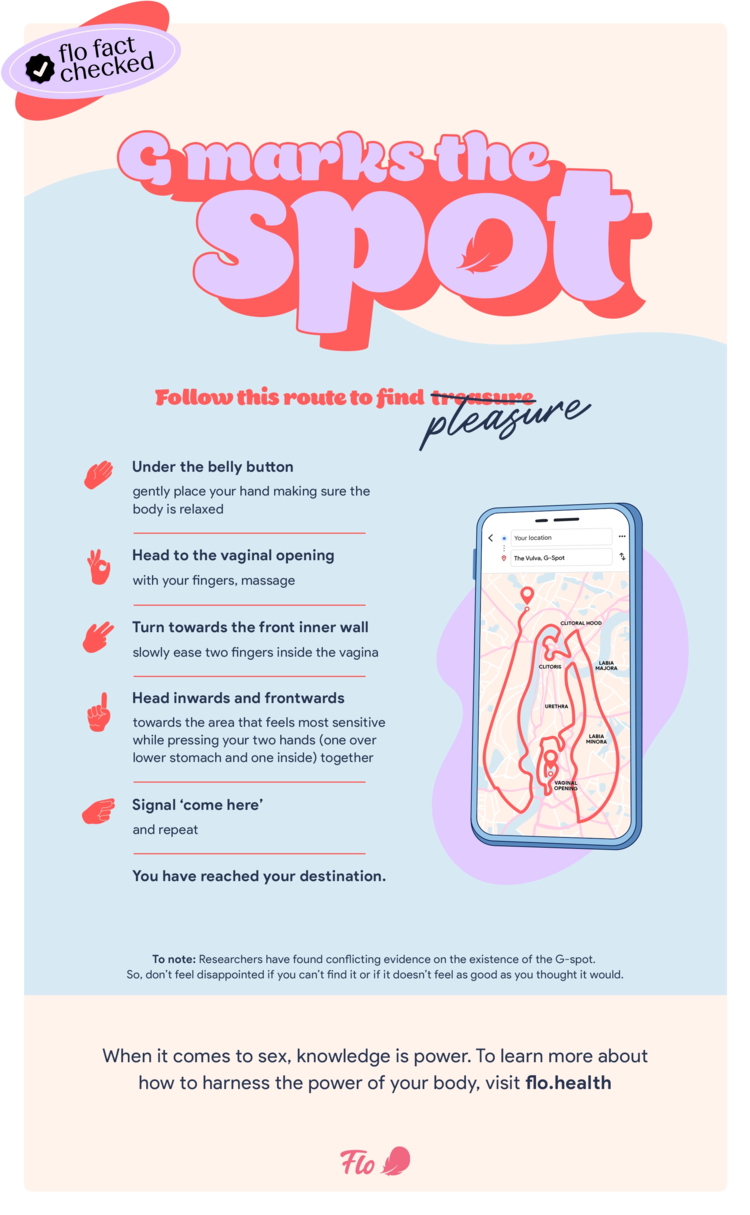Pleasuring yourself or your partner can be a daunting experience, especially if it’s your first time or you’re not sure what you’re doing. But knowing your own body is important, and for women, this includes knowing where your clitoris is (and trust us, you’ll want your partner to be able to find it too!). That’s why we’ve created two maps to make finding the clitoris and female G-spot easier.
To note, there is debate if the female G-spot really exists. So if you can’t find it, don’t worry about it. However, if you’re looking for the erogenous area on the upper vaginal wall, it’s likely to be roughly where we’ve marked it on the map below.
How to find the clitoris
Introducing the Sex-Nav map, a simplified navigation to find the clitoris. It’s important to note that every vulva is different, so your route to clitoral stimulation may differ slightly, but this is a good place to start. So to begin, where is the clitoris?
The clitoris has one of the highest concentrations of nerve endings in the female body, making it super sensitive. That’s why touching it feels so good. Of course, you can be satisfied in other ways, but if you want to masturbate and find your own clitoris (or a partner’s during sex), here’s how to start. First, look for a small bump under the clitoral hood toward the top of the vulva where the inner labia (or lips) meet. This is called the “glans clitoris,” but know that from there, the clitoris extends down inside the body, framing the labia.
When you’re aroused, your clitoris will increase in size — much like a penis does. If you’re struggling, you could use a mirror to help locate your clitoris.
Use your hands and fingers to feel for the clitoral hood and clitoris. When you’ve found it, gently rub the area and move your finger slowly around, trying different motions to discover what you (or your partner) like best.
For penetrative sex or masturbation, you might wonder why stimulating the clitoris matters. It’s simple. Most women cannot orgasm simply from penetrative vaginal sex, so knowing how to stimulate the clitoris is very important to increase pleasure and the likelihood of an orgasm for you and your partner.
How to find the female G-spot
In theory, the G-spot is an erogenous zone inside the vaginal canal that can create feelings of pleasure (for some people) when pressed. Want to give finding it a try? Follow our pleasure map below or read on for our guide.
Struggling to locate it? Think of the G-spot as a rough and bumpy erogenous area on the upper vaginal wall that, for some people, is as sensitive as the clitoris.
It’s best to be turned on, so get yourself in the mood. Then use your fingers (one or two) to go inside the vagina and head up toward the clitoral area from the inside. The G-spot will feel similar to the roof of a mouth, but slightly rougher and spongier. Remember that the position can vary, so make sure you feel around gently until you’ve found it.
Curling the fingers and making a “come here” motion is a great way to stimulate it, so give this a try once you think you’ve located it.
You may want to try using lube to comfortably get your fingers or a sex toy inside your vagina, so feel free to use any extras that you want. And — most importantly — have fun!
Don’t worry if you don’t feel any particular pleasure from the G-spot. Some people don’t.
From the experts
Jordan Rullo, PhD, clinical health psychologist and certified sex therapist, offers some more insight.
What would you say to someone who’s looking for the clitoris or G-spot for the first time? What if they have a hard time finding either zone?
First, I’d say, congratulations! This is a very important step in learning about your body, your sexual arousal, and connecting with your sexuality. In preparation for this exploration, set yourself up for success by creating a comfortable environment with no pressure or expectations. Create the mindset that you are simply exploring your body, with no set goal. Whatever you discover (or don’t discover) is one step toward learning about your sexuality.
If you have difficulty finding your clitoris, despite using a hand mirror to get a different viewpoint and reviewing anatomical images online, try to find it using sensation alone. Slowly, and with lube, rub all areas of your genitals and let the sensations guide you. You may end up finding your clitoris simply because it’s the area that feels most pleasurable when stimulated.
If you have difficulty finding your G-spot, it could be for a couple reasons. First, women typically report that they need to be highly aroused for G-spot stimulation to feel pleasurable. So, perhaps you found the G-spot, but if you’re not in a state of high arousal, stimulating it doesn’t feel very enjoyable. Second, you may not have a G-spot. Not all women report having a G-spot, and research can’t even agree if G-spots exist. So, if you’re not finding it, don’t fret. It may simply be that it’s not a part of your sexual menu.
How important is it as women to know and understand our own bodies, especially when it comes to sex?
So important! If you don’t know and understand your body, what’s arousing, what’s a turn-on and turnoff, how will you be able to share this with a partner? When it comes to partnered sex, not knowing your body, sexuality, or what builds your sexual arousal is like trying to teach someone to drive a car when you don’t know how to do it either.
Is sex always about orgasming? Or can it be about more? Or less?
Sex is definitely NOT all about orgasming. Orgasm is actually one small part of sex! Sex is about connection, pleasure, excitement, skin-to-skin contact, building trust, sharing an experience, having fun, being present … and so much more! Orgasm is just one component of a much larger and more complex experience.
Does the female G-spot really exist? What does the research say?
This is a controversial question with mixed findings in the literature. Of these G-spot studies, there is a lack of consensus about whether it exists. A more recent theory is that it’s not actually a spot. Instead, it’s an area called the clitourethrovaginal complex. This is an area where the clitoris, urethra, and anterior vaginal wall interact, and when stimulated, it could increase orgasmic response. Regardless of whether the G-spot can be definitively identified in research, it is clear that some women report a spot or area that provides heightened arousal when stimulated.
References
- Alzate, Heli. “Vaginal Eroticism: A Replication Study.” Archives of Sexual Behavior, vol. 14, 1985, pp. 529–37, https://doi.org/10.1007/BF01541753.
- “Clitoris.” Cleveland Clinic, my.clevelandclinic.org/health/body/22823-clitoris. Accessed 4 Oct. 2023.
- Herbenick, Debby, et al. “Women’s Experiences with Genital Touching, Sexual Pleasure, and Orgasm: Results from a U.S. Probability Sample of Women Ages 18 to 94.” Journal of Sex and Marital Therapy, vol. 44, no. 2, 2018, pp. 201–12, www.tandfonline.com/doi/full/10.1080/0092623X.2017.1346530.
- “How to Masturbate.” Flo Health, 24 Dec. 2019, flo.health/menstrual-cycle/sex/masturbation/how-to-masturbate.
- Hoag, Nathan, et al. “The ‘G-Spot’ Is Not a Structure Evident on Macroscopic Anatomic Dissection of the Vaginal Wall.” The Journal of Sexual Medicine, vol. 14, no. 12, Dec. 2017, pp. 1524–32, linkinghub.elsevier.com/retrieve/pii/S1743609517315448.
- Hoch, Zwi. “Vaginal Erotic Sensitivity by Sexological Examination.” Acta Obstetricia et Gynecologica Scandinavica, vol. 65, no. 7, Jan. 1986, pp. 767–73, https://doi.org/10.3109/00016348609161498.
- Davidson, J. Kenneth, et al. “The Role of the Grafenberg Spot and Female Ejaculation in the Female Orgasmic Response: An Empirical Analysis.” Journal of Sex and Marital Therapy, vol. 15, no. 2, 1989, pp. 102–20, DOI: 10.1080/00926238908403815.
- Perry, John Delbert, and Beverly Whipple. “Pelvic Muscle Strength of Female Ejaculators: Evidence in Support of a New Theory of Orgasm.” The Journal of Sex Research, vol. 17, no. 1, 1981, pp. 22–39, DOI: 10.1080/00224498109551095.
- Mollaioli, Daniele, et al. “Do We Still Believe There Is a G-spot?” Current Sexual Health Reports, vol. 13, 27 July 2021, pp. 97–105, https://doi.org/10.1007/s11930-021-00311-w.
- Vieira-Baptista, Pedro, et al. “G-Spot: Fact or Fiction? A Systematic Review.” Sexual Medicine, vol. 9, no. 5, 2021, p. 1, https://doi.org/10.1016/j.esxm.2021.100435.
- Foldes, Pierre, and Odile Buisson. “The Clitoral Complex: A Dynamic Sonographic Study.” The Journal of Sexual Medicine, vol. 6, no. 5, May 2009, pp. 1223–31, https://doi.org/10.1111/j.1743-6109.2009.01231.x.
- Puppo, Vincenzo. “Anatomy and Physiology of the Clitoris, Vestibular Bulbs, and Labia Minora with a Review of the Female Orgasm and the Prevention of Female Sexual Dysfunction.” Clinical Anatomy, vol. 26, no. 1, Jan. 2013, pp. 134–52, https://doi.org/10.1002/ca.22177.

